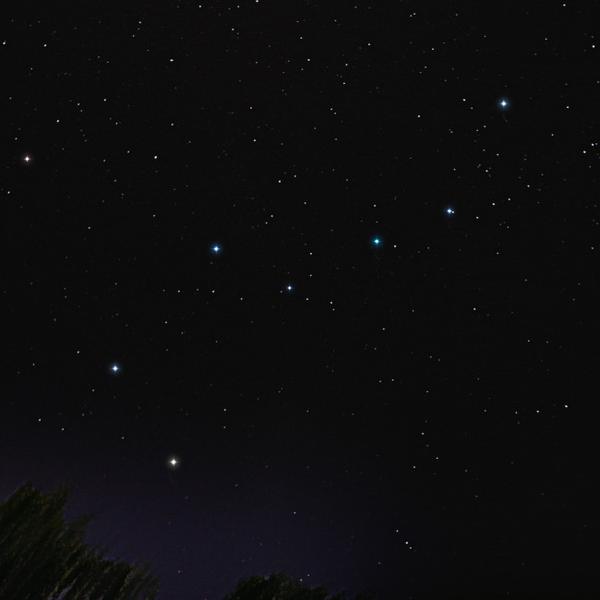This page describes an image Big Dipper
Image caption:
Honourable mention in the 2022 IAU OAE Astrophotography Contest, category Still images of celestial patterns.
This photograph, taken in Udupi, India, in May 2021, shows the seven brightest stars in the constellation Ursa Major. This asterism was seen as a Wagon by the Babylonians, which probably led to the alternative interpretation of the Chariot in the didactic poem of the Greek poet Aratus. The normal Greek interpretation is the constellation of the Great She-Bear, which also includes many fainter stars in a much broader area of the sky.
In ancient Egypt, these seven stars form the figure of the Bull’s Foreleg or the Bull’s Thigh. It is considered a part of the leg of the god Seth, who was considered the evil one of two brothers; the god Osiris (who is sometimes considered the first king of Egypt) was murdered by his brother Seth. Their loving sister put together the scattered pieces of the corpse and reanimated him. In order to prevent Seth from further evil deeds, this leg was attached to a dowel in the sky.
These seven bright stars were considered The Northern Dipper, containing the asterism of the Judges by the nobility in Ancient China. In French and in Dutch, it is called a Saucepan, in German a Chariot and in British English a Plough. The commonly known term “Big Dipper” is American English. They are considered the male figure who is the father of all stars and humans in the North American Navajo saga, where he is said to be the husband of a mother goddess seen in Cassiopeia. Similarly, it is designated the Man’s Cart in Norse mythology with the Woman’s Cart in Ursa Minor. In some other northern cultures, the group is interpreted as an Elk, for instance for the Inuits and Siberians, while the Sami see the Bow and Arrow of Favdna here. In contrast, not all cultures in the southern hemisphere named it because it is always either close to the horizon or invisible. For instance, the Brazilian Tucano people called it the Large Anus of the Snake and in Samoa it forms part of the Heirloom Warclub.
The Hawaiian people also used the asterism for navigation and called it The Seven, while the Macedonian tradition interpreted it as Seven Thieves. In Italian star lore, it is either called The Seven Oxen (Rome) or The Seven Brothers (Sardinia). Similarly, the Mongolian traditions speak of Seven Buddahs while the Indians call it the Seven Sages.
Scroll to captions in other languages
Image credit:
Arya Anthony/IAU OAE
DOI: 10.5281/zenodo.7425524
Related glossary terms:
Asterism
, Big Dipper
Categories:
Naked Eye Astronomy
, Stars
Image license: Creative Commons Attribution 4.0 International (CC BY 4.0) Creative Commons Attribution 4.0 International (CC BY 4.0) icons
The media file captions presented on the OAE website were written, translated and reviewed by a collective effort from the OAE, the OAE Centers and Nodes, the OAE National Astronomy Education Coordinators (NAECs) and other volunteers. You can find a full list of credits for our translation project here. All media file captions are released under a Creative Commons CC BY-4.0 license and should be credited to "IAU OAE". The media files themselves may have different licenses (see above) and should be credited as listed above under "credit".
If you notice a factual error in this caption or an error in any of its translations then please get in touch.
Captions in Different Languages:
Image caption: ২০২২ আইএইউ ওএই অ্যাস্ট্রোফটোগ্রাফি প্রতিযোগিতায় সম্মানজনক উল্লেখ, স্বর্গীয় নিদর্শনের স্থির চিত্র।
২০২১ সালের মে মাসে ভারতের উডুপিতে তোলা এই ফটোগ্রাফটিতে উর্সা মেজর নক্ষত্রমণ্ডলের সাতটি উজ্জ্বল নক্ষত্র দেখানো হয়েছে। এই নক্ষত্রবাদকে ব্যাবিলনীয়রা একটি ওয়াগন হিসাবে দেখেছিল, যা সম্ভবত গ্রীক কবি আরাতুসের উপদেশমূলক কবিতায় রথের বিকল্প ব্যাখ্যার দিকে পরিচালিত করেছিল। সাধারণ গ্রীক ব্যাখ্যা হল গ্রেট শে-বিয়ারের নক্ষত্রমণ্ডল, যা আকাশের অনেক বিস্তৃত অঞ্চলে অনেক ক্ষীণ তারাও অন্তর্ভুক্ত করে।
প্রাচীন মিশরে, এই সাতটি তারা ষাঁড়ের অগ্রভাগ বা ষাঁড়ের উরুর চিত্র তৈরি করে। এটি দেবতা শেঠের পায়ের একটি অংশ হিসাবে বিবেচিত হয়, যাকে দুই ভাইয়ের মধ্যে দুষ্ট মনে করা হত; দেবতা ওসিরিস (যাকে কখনও কখনও মিশরের প্রথম রাজা হিসাবে বিবেচনা করা হয়) তার ভাই সেথ দ্বারা হত্যা করা হয়েছিল। তাদের স্নেহময় বোন মৃতদেহের বিক্ষিপ্ত টুকরোগুলো একত্র করে তাকে পুনরুজ্জীবিত করে। শেঠকে আরও খারাপ কাজ থেকে বিরত রাখার জন্য, এই পাটি আকাশের একটি দোয়েলের সাথে সংযুক্ত ছিল।
এই সাতটি উজ্জ্বল নক্ষত্রকে দ্য নর্দার্ন ডিপার হিসেবে বিবেচনা করা হত, যেখানে প্রাচীন চীনের অভিজাতদের দ্বারা বিচারকদের নক্ষত্রবাদ রয়েছে। ফরাসি এবং ডাচ ভাষায় একে বলা হয় সসপ্যান, জার্মান ভাষায় চ্যারিয়ট এবং ব্রিটিশ ইংরেজিতে লাঙল। সাধারণভাবে পরিচিত শব্দ "বিগ ডিপার" হল আমেরিকান ইংরেজি। তাদের পুরুষ ব্যক্তিত্ব হিসাবে বিবেচনা করা হয় যিনি উত্তর আমেরিকার নাভাজো কাহিনীতে সমস্ত নক্ষত্র এবং মানুষের পিতা, যেখানে তিনি ক্যাসিওপিয়াতে দেখা একটি মাতৃদেবীর স্বামী বলে মনে করা হয়। একইভাবে, এটি উর্সা মাইনরে নারীর কার্টের সাথে নর্স পুরাণে ম্যানস কার্ট মনোনীত হয়েছে। অন্য কিছু উত্তরের সংস্কৃতিতে, দলটিকে এলক হিসাবে ব্যাখ্যা করা হয়, উদাহরণস্বরূপ ইনুইট এবং সাইবেরিয়ানদের জন্য, যখন সামিরা এখানে ফাভডনার ধনুক এবং তীর দেখতে পায়। বিপরীতে, দক্ষিণ গোলার্ধের সমস্ত সংস্কৃতি এটির নাম দেয় না কারণ এটি সর্বদা দিগন্তের কাছাকাছি থাকে বা অদৃশ্য থাকে। উদাহরণস্বরূপ, ব্রাজিলিয়ান টুকানো লোকেরা এটিকে সাপের বড় মলদ্বার বলে এবং সামোয়াতে এটি হেয়ারলুম ওয়ারক্লাবের অংশ।
হাওয়াইয়ান জনগণ নৌচলাচলের জন্য নক্ষত্রবিদ্যা ব্যবহার করে এবং এটিকে দ্য সেভেন বলে, যখন ম্যাসেডোনীয় ঐতিহ্য এটিকে সাত চোর হিসাবে ব্যাখ্যা করে। ইতালীয় তারকা বিদ্যায়, একে হয় দ্য সেভেন অক্সেন (রোম) বা দ্য সেভেন ব্রাদার্স (সার্ডিনিয়া) বলা হয়। একইভাবে, মঙ্গোলীয় ঐতিহ্য সাত বুদ্ধের কথা বলে যখন ভারতীয়রা এটিকে সপ্ত ঋষি বলে।
Image credit: আর্য অ্যান্টনি/আইএইউ ওএই
Related glossary terms: Asterism , Big Dipper Caption translation status: Not yet approved by a reviewer
Caption translators: Raktim Mukherjee
Image caption: Lobende Erwähnung beim IAU OAE Astrofoto-Wettbewerb 2022, Kategorie Weitwinkelaufnahmen von Himmelsmustern.
Dieses Foto, aufgenommen im Mai 2021 in Udupi in Indien, zeigt die sieben hellsten Sterne im Sternbild der Großen Bärin (lat. Ursa Major). Dieser Asterismus wurde von den Babyloniern als Wagen gesehen, was wahrscheinlich zu der alternativen Interpretation des Streitwagens im Lehrgedicht des griechischen Dichters Aratus führte. Die übliche griechische Deutung ist das Sternbild der Großen Bärin, zu dem auch viele schwächere Sterne in einem viel größeren Bereich des Himmels gehören.
Im alten Ägypten bilden diese sieben Sterne die Figur des Stiervorderbeins oder des Stierschenkels. Sie gilt als Teil des Beins des Gottes Seth, der als der böse von zwei Brüdern galt: Der Gott Osiris (der manchmal als erster König Ägyptens angesehen wird) wurde von seinem Bruder Seth ermordet. Ihre liebende Schwester setzte die verstreuten Teile seines Leichnams zusammen und belebte ihn wieder. Um Seth von weiteren bösen Taten abzuhalten, wurde dieses Bein an einem Dübel am Himmel befestigt.
Diese sieben hellen Sterne wurden vom Adel im alten China als Nördliche Schöpfkelle betrachtet, der die Sternbilder der Richter enthält. Im Französischen und im Niederländischen wird er als Kochtopf, im Deutschen als Wagen und im britischen Englisch als Pflug bezeichnet. Weltweit verbreitet ist der Begriff "Big Dipper" (Große Schöpfkelle) aus dem amerikanischen Englisch. In der nordamerikanischen Navajo-Saga gelten diese Sterne als die männliche Figur, die der Vater aller Sterne und Menschen ist, da er der Ehemann einer Muttergöttin sein soll, die sich in der Kassiopeia wiederfindet. In ähnlicher Weise wird er in der nordischen Mythologie als der Wagen des Mannes bezeichnet, während der Wagen der Frau in Form der Kleinen Bärin (lat. Ursa Minor) zu sehen ist. In einigen anderen nördlichen Kulturen wird die Gruppe als Elch interpretiert, beispielsweise bei den Inuit und Sibirern, während die Sami hier den Bogen und den Pfeil von Favdna sehen. Im Gegensatz dazu haben nicht alle Kulturen der Südhalbkugel ihm einen Namen gegeben, weil er dort immer entweder nahe am Horizont oder unsichtbar ist. Das brasilianische Volk der Tucano beispielsweise nannte ihn den Großen Anus der Schlange, und in Samoa ist er Teil der Heiligen Keule.
Die Hawaiianischen Ureinwohner nutzten diesen Asterismus auch zur Navigation und nannten ihn Die Sieben, während die mazedonische Tradition ihn als Sieben Diebe interpretierte. In der italienischen Sternenkunde wird er entweder Die sieben Ochsen (Rom) oder Die sieben Brüder (Sardinien) genannt. In ähnlicher Weise sprechen die mongolischen Traditionen von den Sieben Buddhas, während er in Indien die Sieben Weisen genannt wird.
Image credit: Arya Anthony/IAU OAE
Related glossary terms: Asterismus , Großer Wagen Caption translation status: Not yet approved by a reviewer
Caption translators: Carolin Liefke
Image caption: Menzione d'onore al concorso di astrofotografia IAU OAE 2022, categoria Immagini fisse di modelli celesti.
Questa fotografia, scattata a Udupi, in India, nel maggio 2021, mostra le sette stelle più luminose della costellazione dell'Orsa Maggiore. Questo asterismo era visto come un Carro dai Babilonesi, il che probabilmente ha portato all'interpretazione alternativa del Carro nel poema didattico del poeta greco Arato. La normale interpretazione greca è la costellazione della Grande Orsa, che comprende anche molte stelle più deboli in un'area molto più ampia del cielo.
Nell'antico Egitto, queste sette stelle formano la figura della Zampa o della Coscia del Toro. È considerata una parte della gamba del dio Seth, che era considerato il cattivo di due fratelli; il dio Osiride (che a volte è considerato il primo re d'Egitto) fu ucciso dal fratello Seth. La loro amorevole sorella mise insieme i pezzi sparsi del cadavere e lo rianimò. Per impedire a Seth di compiere ulteriori azioni malvagie, questa gamba fu attaccata a un tassello nel cielo.
Queste sette stelle luminose erano considerate l'Orsa Maggiore, contenente l'asterismo dei Giudici dalla nobiltà dell'Antica Cina. In francese e in olandese è chiamata pentola, in tedesco carro e in inglese britannico aratro. Il termine comunemente noto "Big Dipper" è dell'inglese americano. È considerato la figura maschile padre di tutte le stelle e degli esseri umani nella saga nordamericana dei Navajo, dove si dice che sia il marito di una dea madre vista in Cassiopea. Allo stesso modo, nella mitologia nordica viene designato il Carro dell'Uomo con il Carro della Donna nell'Orsa Minore. In alcune altre culture settentrionali, il gruppo è interpretato come un alce, ad esempio per gli Inuit e i Siberiani, mentre i Sami vi vedono l'arco e la freccia di Favdna. Al contrario, non tutte le culture dell'emisfero meridionale lo nominano perché è sempre vicino all'orizzonte o invisibile. Per esempio, i Tucano brasiliani lo chiamavano il Grande Ano del Serpente e a Samoa fa parte dei cimeli di famiglia - "Heirloom Warclub".
Anche le popolazioni hawaiane utilizzavano l'asterismo per la navigazione e lo chiamavano I Sette, mentre la tradizione macedone lo interpretava come Sette Ladri. Nella tradizione stellare italiana è chiamato I Sette Buoi (Roma) o I Sette Fratelli (Sardegna). Allo stesso modo, le tradizioni mongole parlano di Sette Budda, mentre gli indiani lo chiamano Sette Saggi.
Image credit: Arya Anthony/IAU OAE
Related glossary terms: Asterismo , Grande Carro Caption translation status: Approved by a reviewer
Caption translators: Giuliana Giobbi
Caption reviewers: Rodolfo Canestrari
Image caption: 2022年国际天文学联合会(IAU)OAE天文摄影比赛静态天体图案类别荣誉奖作品。
这张照片2021年5月拍摄于印度乌杜皮,显示了大熊座中最亮的七颗星。这个星群被古巴比伦人视为一驾马车,这很可能启发了古希腊诗人阿拉托斯在训诲诗中将其视为战车。而古希腊人通常将这七颗星与更广阔的天区中许多更暗的恒星一起构成一个星座,视为一只大母熊。
在古埃及,这七颗星组成的图案被视作公牛前腿或公牛大腿,被认为是塞特神腿的一部分。塞特神被认为是两兄弟中邪恶的一个,他谋杀了自己的哥哥奥西里斯神(有时被认为是埃及第一位国王)。他们深爱的妹妹把散落的尸体碎片拼凑在一起,使奥西里斯复活。为了防止塞特继续作恶,这条腿被一根销子钉在了天上。
这七颗明亮的恒星被中国古代贵族称为“北斗”,行使着审判的职责。它在法语和荷兰语中被称为“汤锅”,在德语中被称为“战车”,在英国英语中被称为“犁”,在美国英语中被称为“大勺子”。在北美纳瓦霍人的传说中,北斗七星有着男性形象,被认为是所有星辰和人类的父亲,据说他是仙后座对应的母神的丈夫。同样,在北欧神话中,它被称为“男人之车”,和小熊座中的“女人之车”并列。在其他一些北方文化,例如因纽特人和西伯利亚人的传说中,这个星群被解释为驼鹿,而萨米人在这里看到的是法夫德纳的弓和箭。相比之下,在南半球,并非所有文化都将其命名,因为它总是要么靠近地平线,要么看不见。例如,巴西的图卡诺人称它为“蛇的大肛门”;而在萨摩亚,它是“祖传战棍”的一部分。
夏威夷人也将其用于航海,并称之为“七星”,而马其顿传统则将其解释为“七贼”。在意大利的星象传说中,它在罗马被称为“七牛”,在撒丁岛被称为“七兄弟”。同样,蒙古的传统说法是“七佛”,而印度人则称之为“七圣”。
Image credit: Arya Anthony/IAU OAE
Related glossary terms: 北斗七星 , 星宿(星群) Caption translation status: Not yet approved by a reviewer
Caption translators: Bao Lizhuo
Image caption: 2022年國際天文學聯合會(IAU)OAE天文攝影比賽靜態天體圖案類別榮譽獎作品。
這張照片2021年5月拍攝於印度烏杜皮,顯示了大熊座中最亮的七顆星。這個星群被古巴比倫人視為一駕馬車,這很可能啟發了古希臘詩人阿拉托斯在訓誨詩中將其視為戰車。而古希臘人通常將這七顆星與更廣闊的天區中許多更暗的恆星一起構成一個星座,視為一隻大母熊。
在古埃及,這七顆星組成的圖案被視作公牛前腿或公牛大腿,被認為是塞特神腿的一部分。塞特神被認為是兩兄弟中邪惡的一個,他謀殺了自己的哥哥奧西里斯神(有時被認為是埃及第一位國王)。他們深愛的妹妹把散落的屍體碎片拼湊在一起,使奧西里斯復活。為了防止塞特繼續作惡,這條腿被一根銷子釘在了天上。
這七顆明亮的恆星被中國古代貴族稱為“北斗”,行使著審判的職責。它在法語和荷蘭語中被稱為“湯鍋”,在德語中被稱為“戰車”,在英國英語中被稱為“犁”,在美國英語中被稱為“大勺子”。在北美納瓦霍人的傳說中,北斗七星有著男性形象,被認為是所有星辰和人類的父親,據說他是仙後座對應的母神的丈夫。同樣,在北歐神話中,它被稱為“男人之車”,和小熊座中的“女人之車”并列。在其他一些北方文化,例如因紐特人和西伯利亞人的傳說中,這個星群被解釋為駝鹿,而薩米人在這裡看到的是法夫德納的弓和箭。相比之下,在南半球,並非所有文化都將其命名,因為它總是要麼靠近地平線,要麼看不見。例如,巴西的圖卡諾人稱它為“蛇的大肛門”;而在薩摩亞,它是“祖傳戰棍”的一部分。
夏威夷人也將其用於航海,並稱之為“七星”,而馬其頓傳統則將其解釋為“七賊”。在意大利的星象傳說中,它在羅馬被稱為“七牛”,在撒丁島被稱為“七兄弟”。同樣,蒙古的傳統說法是“七佛”,而印度人則稱之為“七聖”。
Image credit: Arya Anthony/IAU OAE
Related glossary terms: 北斗七星 , 星宿(星群) Caption translation status: Not yet approved by a reviewer
Caption translators: An automated transliteration from the simplified Chinese translation by - Bao Lizhuo









